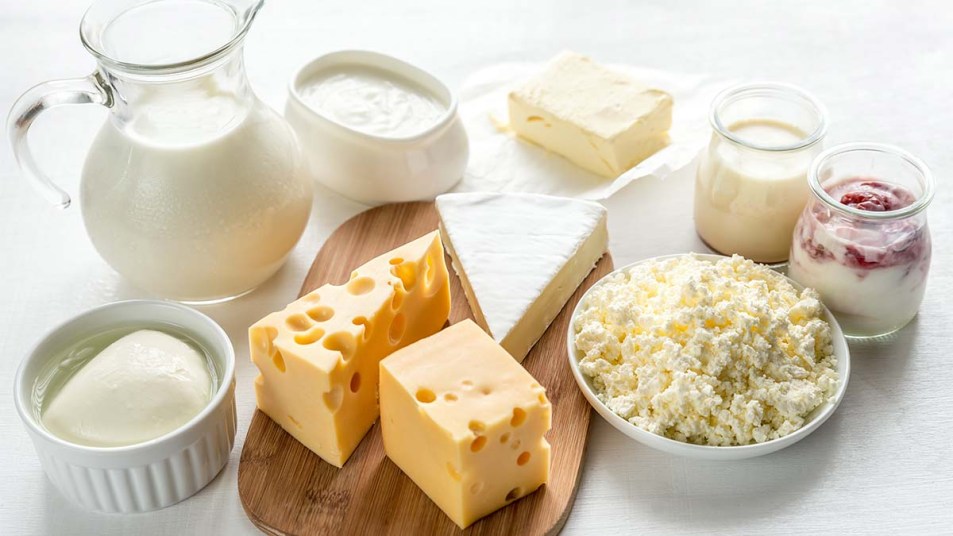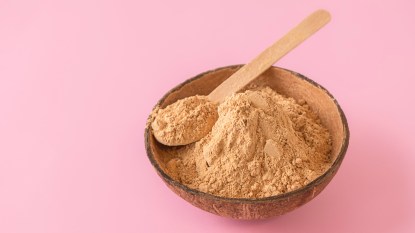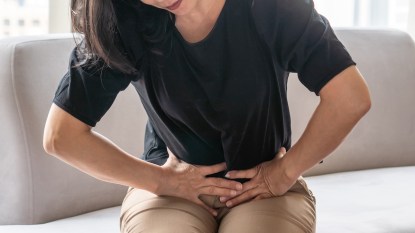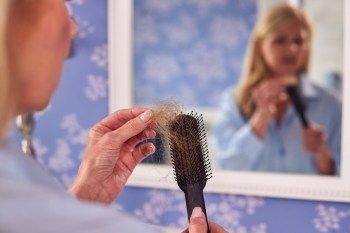Reduce Perimenopause Symptoms by Adding These 4 Foods to Your Diet
Plus, learn about which foods trigger hot flashes, weight gain, and more.

Perimenopause is the time during which a woman’s body prepares for menopause. Typically, though not true for all, this change begins in your 40s and 50s. Body changes — such as a decrease in estrogen and egg production — begin, and can trigger bothersome symptoms like hot flashes and irregular menstrual periods. Interestingly, the foods you eat can make these symptoms better or worse.
Caffeine, processed foods, and alcohol are associated with intensifying perimenopause symptoms. Conversely, a diet comprising nutrient-rich foods has therapeutic benefits. As registered dietitian-nutritionist Amy Jamieson-Petonic, RDN, explained to EverydayHealth.com, “Good nutrition can make a big change in how you feel with regard to menopause symptoms like mood swings, hot flashes, and exhaustion, as well as bloating and possible weight gain.”
It’s never a bad time to evaluate how your eating habits are affecting your perimenopause journey. Keep reading to learn more about how perimonenopause impacts appetite; which foods to avoid during perimenopause, and what diet changes are wise during perimenopause.
Does perimenopause affect appetite?
The fluctuation of your hormones during perimenopause can certainly affect your appetite. Levels of a hunger-stimulating hormone called ghrelin tend to increase as estrogen — which suppresses appetite — decreases. Greater amounts of the stress hormone known as cortisol may also elevate appetite. You may be tempted to satisfy your hunger with unhealthy foods and drinks; however, this can lead to bloating and weight gain, which are common menopausal symptoms. Instead, try eating foods that nourish your body with vitamins and minerals on a daily basis, and indulging in guilty treats in moderation.
How can I control my hunger during perimenopause?
Developing a strategy for managing perimenopause cravings will give you better control over them. Below are seven tips recommended by Healthline for keeping food cravings at bay:
- Be aware of your cravings so you can prepare accordingly when they arise.
- Avoid restrictive diets — fuel your body with enough calories to carry out necessary functions.
- Have patience; over time your body will realize that it doesn’t need those less nutritious foods.
- Eat nutrient-dense foods to satisfy your hunger throughout the day.
- Get active and moving to distract your mind from cravings and keep your health in good shape.
- Find ways to control stress so that it doesn’t heighten your appetite.
- Get sufficient amounts of sleep to stay alert and focused.
What other foods should I avoid during perimenopause?
In addition to caffeine, alcohol, and processed foods, spicy dishes are commonly believed to worsen perimenopause symptoms. Spicy foods trigger hot flashes, so you should limit your consumption of them. Another thing to eat in moderation is fatty meats, including bacon and brisket, since they’re high in saturated fat. Excessively consuming this unhealthy fat is linked with a higher risk of weight gain and heart disease. Ultimately, frequent consumption of these foods does more harm than good to your body.
What foods should I eat during perimenopause?
Perimenopause symptoms don’t have to get the best of you. Consuming filling foods will help you navigate hot flashes, mood changes, and sleep problems. Here’s a list from News-Medical.net of four food groups you should target for natural relief:
- Whole grains: Brown rice, wheat bran, and oatmeal are all fiber-rich whole grains that keep you fuller longer. This reduces the need to snack excessively between meals. The USDA recommends that women 31 and older consume up to 3 ½ ounces of whole grains daily as part of their total grain intake.
- Omega-3-rich foods: Salmon and chia seeds are two foods that are good sources of omega-3 fatty acids. These acids play a role in aiding your heart, brain, and immune system function. The National Institutes of Health (NIH) notes that 1.1 grams of omega-3s every day is an adequate intake amount for mature women.
- Calcium: Cheese, milk, yogurt, and sardines all contain calcium. This mineral is key because during perimenopause, lower estrogen production may lead to bone thinning. For strong and healthy bones, the NIH recommends 1,200 milligrams of calcium each day for women 51 and older.
- Legumes: Beans, lentils and peas are packed with fiber and iron. These nutrients are reported to help you avoid weight gain and heart disease. For adults, US Dietary Guidelines recommend consuming 2 to 3 cups of legumes weekly. However, an exact amount will vary depending on your daily calorie intake.
How else do I take care of myself during perimenopause?
Your diet is an essential part of making perimenopause symptoms manageable — but it’s only the first step. Here are five suggestions from the UK’s National Health Service for lifestyle changes you should implement during perimenopause:
- Exercise regularly with physical activities like dancing, walking, and running.
- Try relaxing and restorative activities like yoga, Tai Chi, or meditation.
- Talk to family, friends, or colleagues who are going through the same thing.
- Maintain a consistent sleep schedule.
- Speak with your doctor before taking herbal supplements or other treatments for perimenopause.
The Bottom Line on Perimenopause and Your Diet
Although your body is going through unavoidable changes, there are ways to manage your physical and emotional response to these changes. Maintaining a balanced diet helps reduce perimenopause symptoms and sets you up for a smoother transition to menopause. As the saying goes, “You are what you eat.” So, if you want to feel great, feed your body the right nutrients. Just make sure you talk to your doctor before making any dietary changes to ensure they’re a good fit for you.
Want to learn more about perimenopause? Check out our stories on whether supplements are a worthy option for easing symptoms and how to tell when menopause is about to begin.
This content is not a substitute for professional medical advice or diagnosis. Always consult your physician before pursuing any treatment plan.













